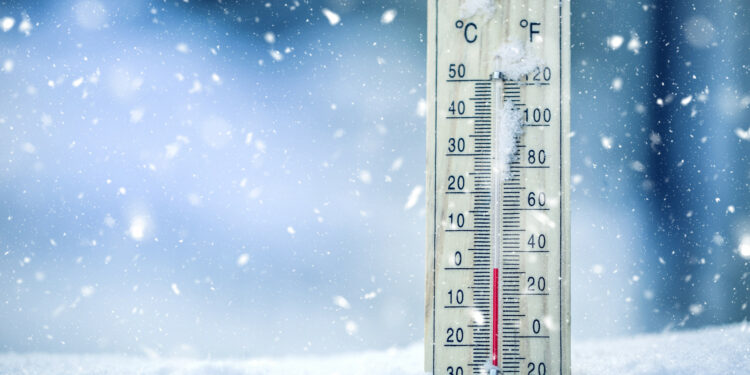A late-season polar vortex could extend America’s winter-like temperatures into early spring, according to AccuWeather.
So far in December, temperatures across the nation have trended above average. The National Weather Service (NWS) Climate Prediction Center expects above-average temperatures to affect more than half the U.S. over the next two weeks, according to its most recent temperature outlooks. Alaska has been among the states with the strongest above-average temperatures.
However, the warmer temperatures aren’t likely to stick around for the entire winter. The seasonal outlook from the NWS Climate Prediction Center shows below-normal temperatures across the Northern and Northwestern U.S., and AccuWeather meteorologists anticipate a possible polar vortex to descend into the U.S. in February.
A stock photo shows a thermometer with snow. A polar vortex could hit the U.S. in February, bringing frigid temperatures, according to meteorologists.
A stock photo shows a thermometer with snow. A polar vortex could hit the U.S. in February, bringing frigid temperatures, according to meteorologists.
MarianVejcik/Getty
AccuWeather long-range expert Paul Pastelok voiced his thoughts about the polar vortex forecast in the AccuWeather report, which was published earlier this week. “Then there is the polar vortex at risk in February, especially late, that could extend our winter this year into early spring,” he said.
Should it hit, the polar vortex could prompt “some of the coldest air of the season” during February, the final month of meteorological winter, AccuWeather reported.
A polar vortex is an area of low pressure and cold air that surrounds both of Earth’s poles. The vortex at the North Pole expands in winter, sending cold air south. An NWS fact sheet about the phenomenon says the polar vortex “always exists near the poles but weakens in summer and strengthens in winter.”
“The term ‘vortex’ refers to the counterclockwise flow of air that helps keep the colder air near the Poles,” the fact sheet said. “Many times during winter…the polar vortex will expand, sending cold air southward with the jet stream. In short, there is no cause to be alarmed when you hear about the polar vortex, but you should be prepared for colder temperatures.”
Pastelok told Newsweek that meteorologists started looking at the chances of a polar vortex disruption earlier this season. He called it a “long process” without a 100 percent guarantee that such a disruption will happen. “But things have been on target already,” he said.
However, the specifics of the polar vortex, such as which states might see colder temperatures, are still impossible to forecast this early.
In addition to the polar vortex, AccuWeather shared a map of the states expecting a change in their historical snowfall this year.
The Southwest, Midwest and parts of the East Coast are expecting below-average snowfall, as well as parts of the Central U.S. Above-average snowfall is forecast for the Northwest and Northern U.S.
Throughout the rest of December, AccuWeather forecasts point to a rainy, snowy time in California. Several storms are expected to hit the Golden State beginning this week and continuing until Christmas. Following a slew of atmospheric rivers in late November, California has had a dry period.
Source link : http://www.bing.com/news/apiclick.aspx?ref=FexRss&aid=&tid=675c70b6045d4f9e8b2fee4b1bf7d350&url=https%3A%2F%2Fwww.newsweek.com%2Fpolar-vortex-may-change-america-winter-1999984&c=11970049497094067331&mkt=en-us
Author :
Publish date : 2024-12-12 05:08:00
Copyright for syndicated content belongs to the linked Source.






